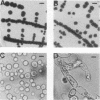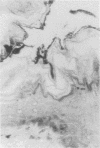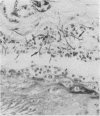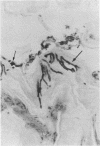Abstract
The opportunistic fungus Candida albicans is a major cause of oral and esophageal infections in immuno-compromised patients, individuals on drug therapy, and the chronically ill. Because it has been observed that persons suffering from hyposalivation have an increased prevalence of oral candididiasis, we developed an animal model of infection based on hyposalivation. The objectives of our studies were to understand the mechanisms by which C. albicans causes oral disease and to begin to elucidate the role played by saliva in controlling C. albicans in the oral cavity. Our results showed that (i) oral Candida infection was established by a small challenge inoculum, (ii) mucosal lesions developed in the oral cavities and esophagi of infected rats, and (iii) transmission of oral Candida infection from an inoculated rat to uninoculated cagemates occurred rapidly. In addition, we compared the abilities of a clinical isolate and a spontaneously derived morphological mutant from that isolate to infect hyposalivatory rats and to induce disease. Infection was induced by the morphological mutant in hyposalivatory rats; however, the morphological mutant took significantly longer to transmit oral infection to uninoculated cagemates than did the parental strain.
Full text
PDF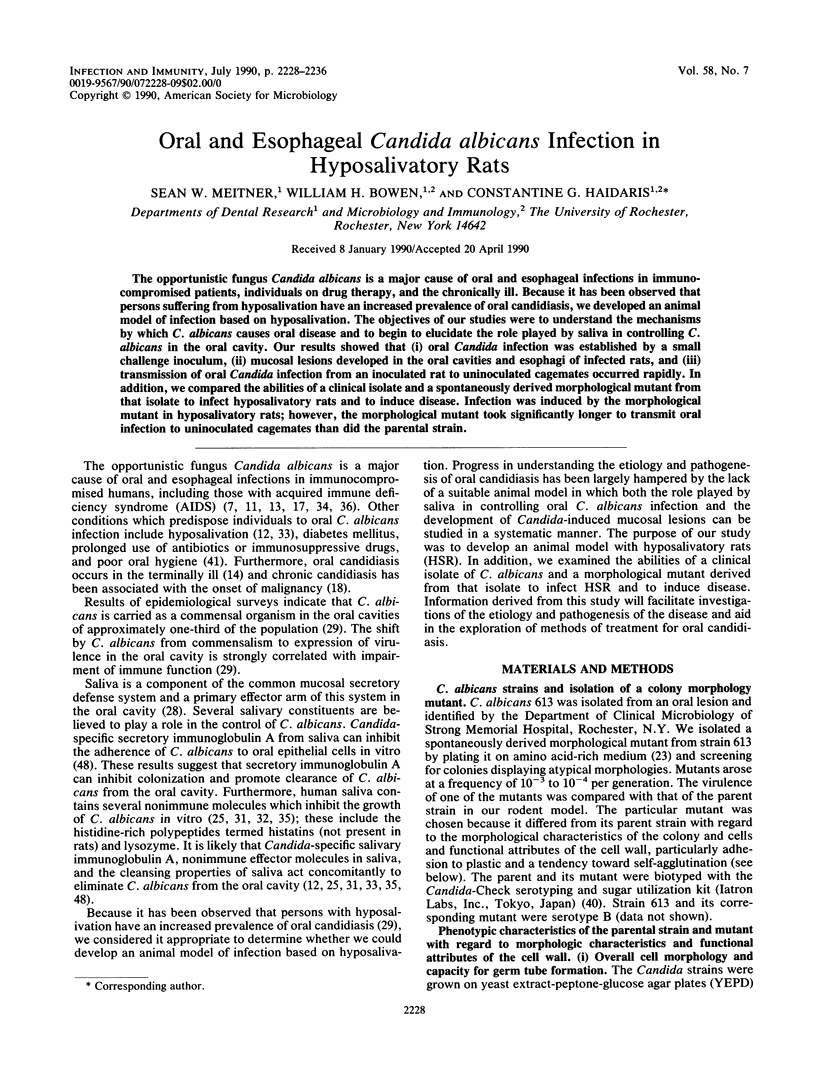
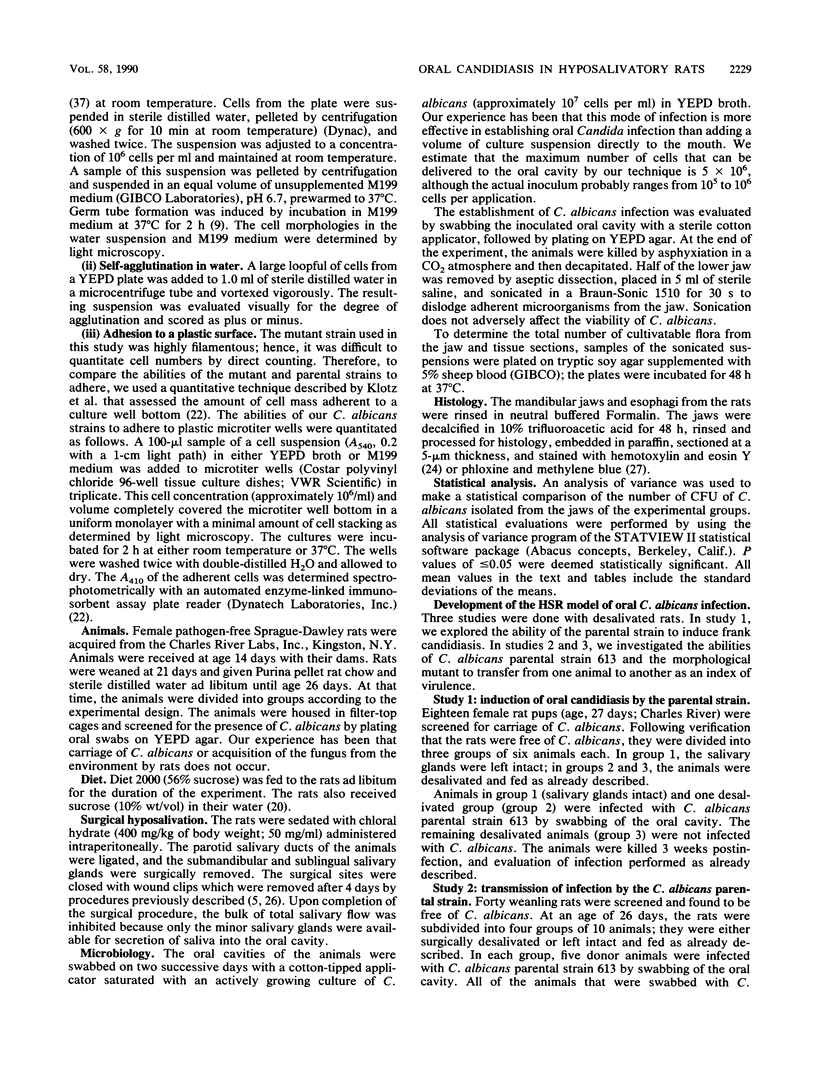
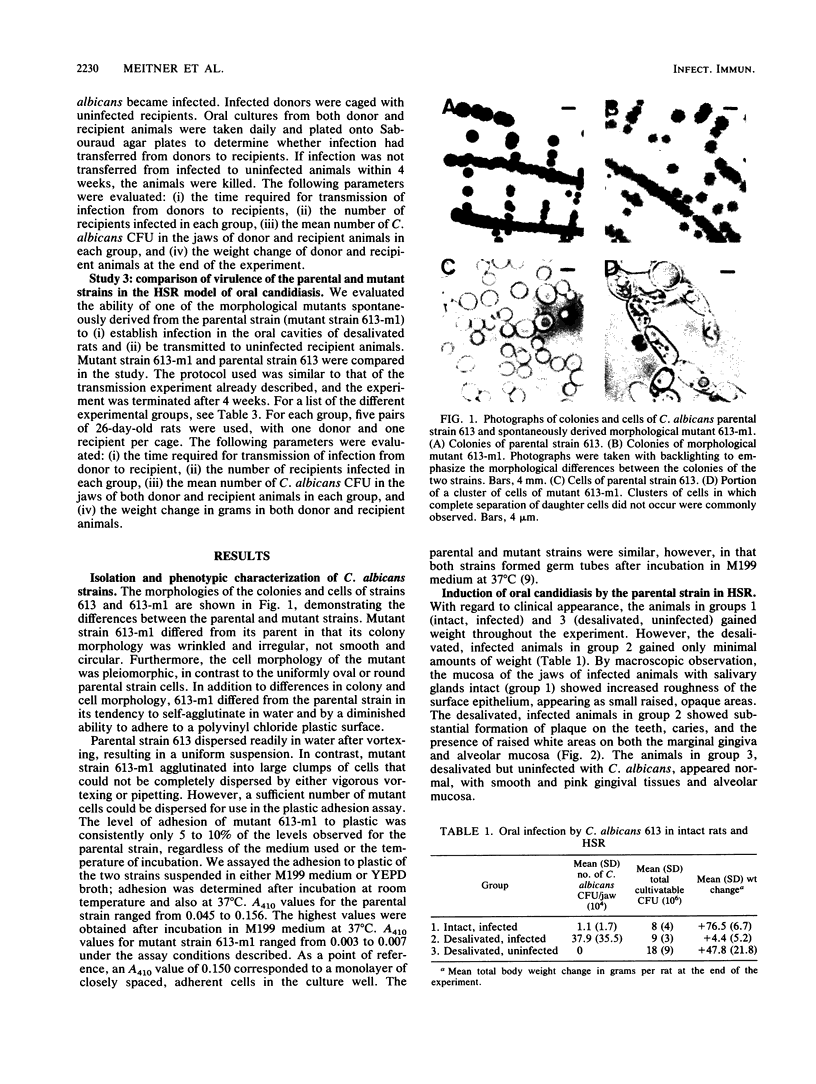
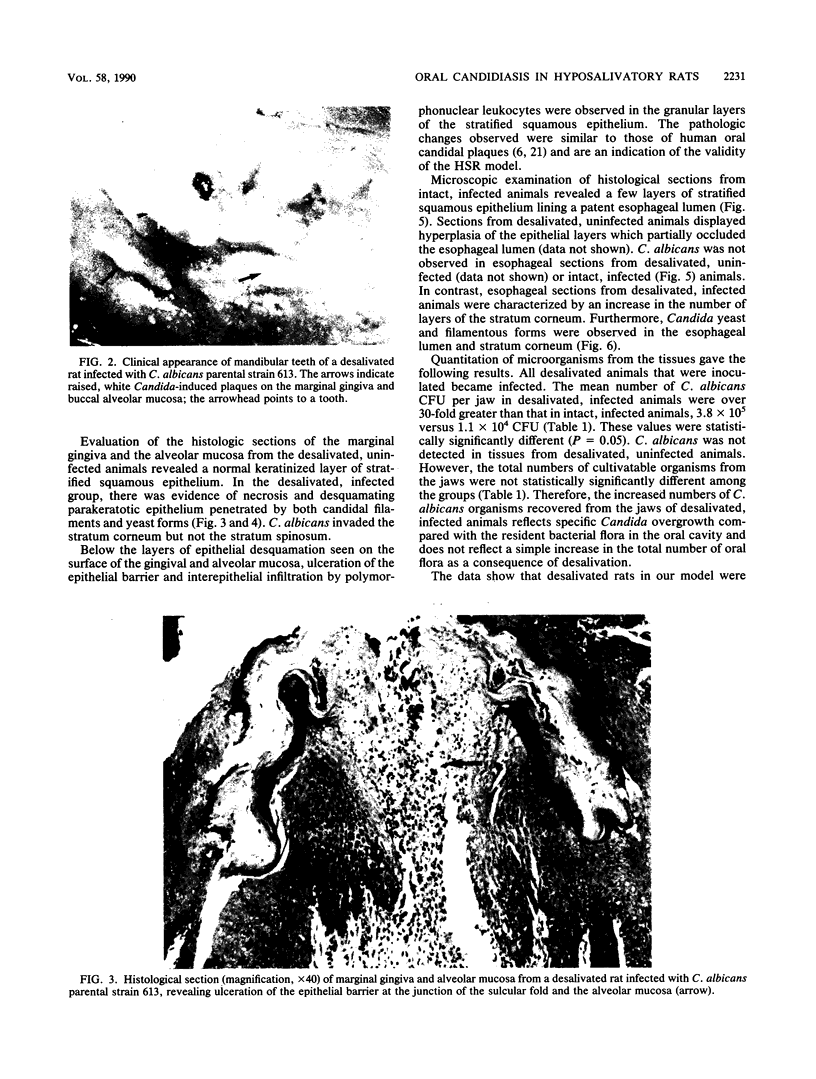
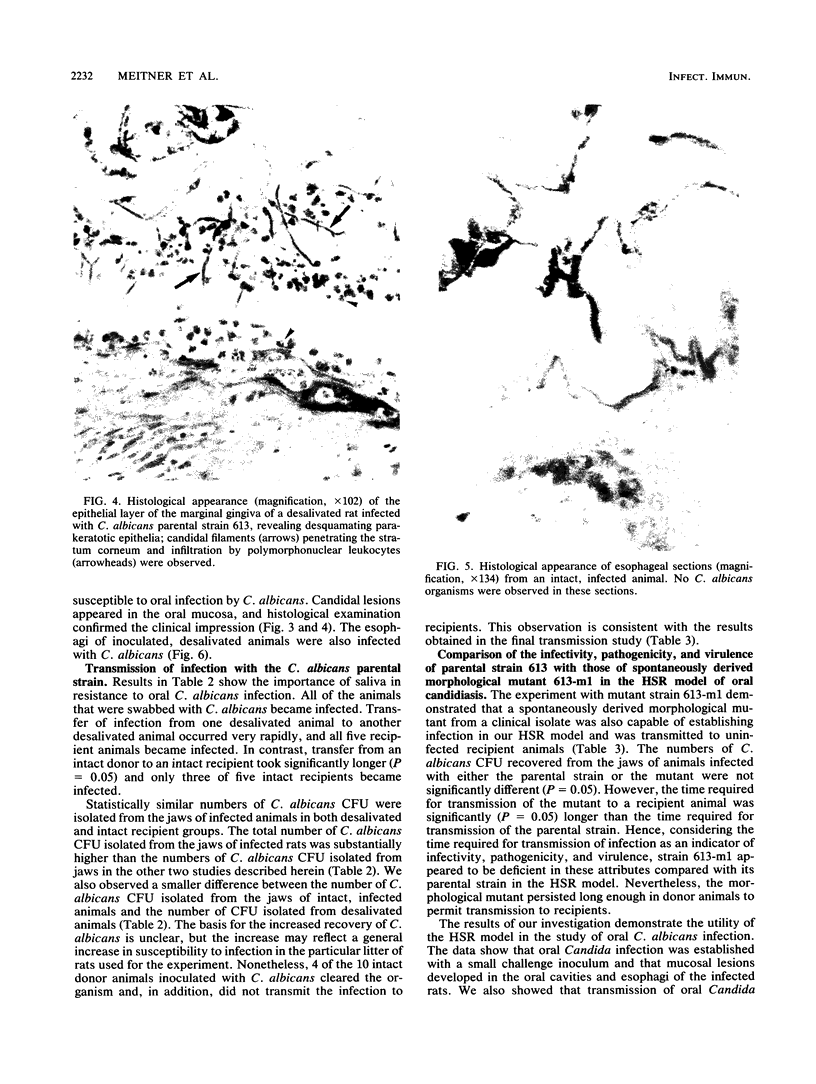
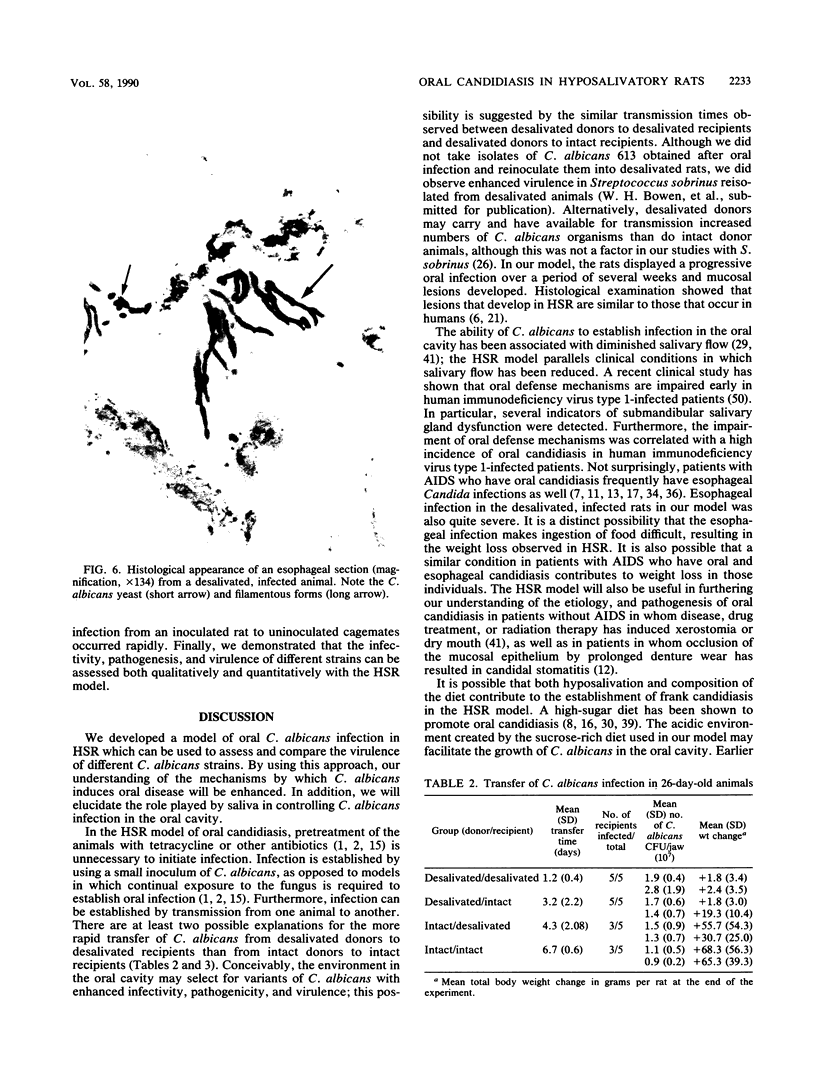
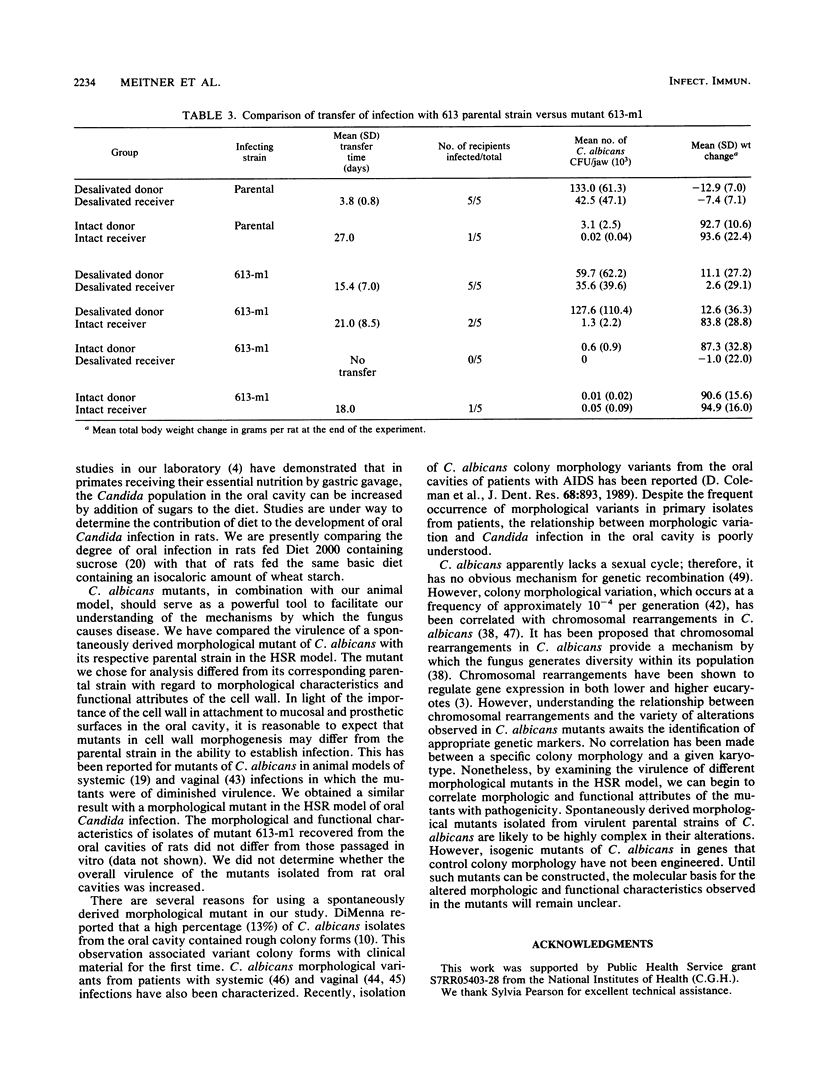
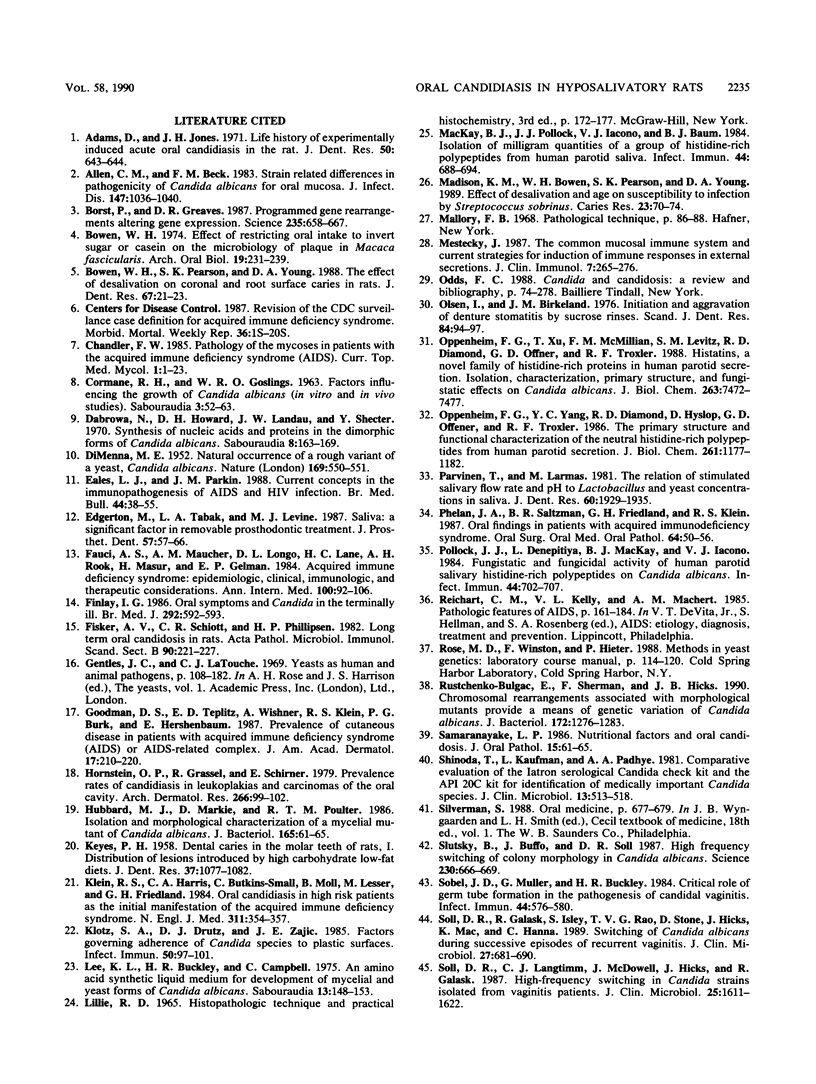
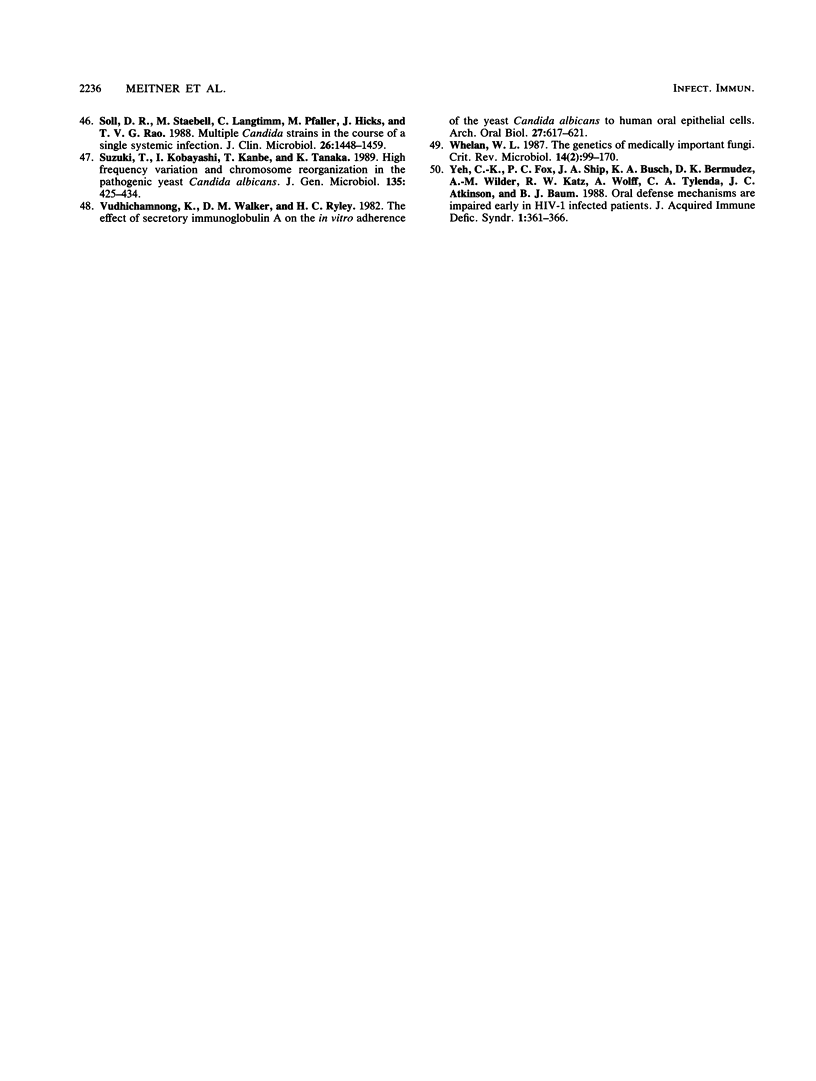
Images in this article
Selected References
These references are in PubMed. This may not be the complete list of references from this article.
- Adams D., Jones J. H. Life history of experimentally induced acute oral candidiasis in the rat. J Dent Res. 1971 May-Jun;50(3):643–644. doi: 10.1177/00220345710500032201. [DOI] [PubMed] [Google Scholar]
- Allen C. M., Beck F. M. Strain-related differences in pathogenicity of Candida albicans for oral mucosa. J Infect Dis. 1983 Jun;147(6):1036–1040. doi: 10.1093/infdis/147.6.1036. [DOI] [PubMed] [Google Scholar]
- Borst P., Greaves D. R. Programmed gene rearrangements altering gene expression. Science. 1987 Feb 6;235(4789):658–667. doi: 10.1126/science.3544215. [DOI] [PubMed] [Google Scholar]
- Bowen W. H. Effect of restricting oral intake to invert sugar or casein on the microbiology of plaque in Macaca fascicularis (irus). Arch Oral Biol. 1974 Mar;19(3):231–239. doi: 10.1016/0003-9969(74)90267-2. [DOI] [PubMed] [Google Scholar]
- Bowen W. H., Pearson S. K., Young D. A. The effect of desalivation on coronal and root surface caries in rats. J Dent Res. 1988 Jan;67(1):21–23. doi: 10.1177/00220345880670010301. [DOI] [PubMed] [Google Scholar]
- Chandler F. W. Pathology of the mycoses in patients with the acquired immunodeficiency syndrome (AIDS). Curr Top Med Mycol. 1985;1:1–23. doi: 10.1007/978-1-4613-9547-8_1. [DOI] [PubMed] [Google Scholar]
- Cormane R. H., Goslings W. R. Factors influencing the growth of Candida albicans (in vivo and in vitro studies). Sabouraudia. 1963 Oct;3(1):52–63. [PubMed] [Google Scholar]
- Dabrowa N., Howard D. H., Landau J. W., Shechter Y. Synthesis of nueic acids and proteins in the dimorphic forms of Candida albicans. Sabouraudia. 1970 Nov;8(3):163–169. doi: 10.1080/00362177085190831. [DOI] [PubMed] [Google Scholar]
- Eales L. J., Parkin J. M. Current concepts in the immunopathogenesis of AIDS and HIV infection. Br Med Bull. 1988 Jan;44(1):38–55. doi: 10.1093/oxfordjournals.bmb.a072245. [DOI] [PubMed] [Google Scholar]
- Edgerton M., Tabak L. A., Levine M. J. Saliva: a significant factor in removable prosthodontic treatment. J Prosthet Dent. 1987 Jan;57(1):57–66. doi: 10.1016/0022-3913(87)90117-x. [DOI] [PubMed] [Google Scholar]
- Fauci A. S., Macher A. M., Longo D. L., Lane H. C., Rook A. H., Masur H., Gelmann E. P. NIH conference. Acquired immunodeficiency syndrome: epidemiologic, clinical, immunologic, and therapeutic considerations. Ann Intern Med. 1984 Jan;100(1):92–106. doi: 10.7326/0003-4819-100-1-92. [DOI] [PubMed] [Google Scholar]
- Finlay I. G. Oral symptoms and candida in the terminally ill. Br Med J (Clin Res Ed) 1986 Mar 1;292(6520):592–593. doi: 10.1136/bmj.292.6520.592. [DOI] [PMC free article] [PubMed] [Google Scholar]
- Fisker A. V., Schiøtt C. R., Philipsen H. P. Long-term oral candidosis in rats. Acta Pathol Microbiol Immunol Scand B. 1982 Jun;90(3):221–227. doi: 10.1111/j.1699-0463.1982.tb00109.x. [DOI] [PubMed] [Google Scholar]
- Goodman D. S., Teplitz E. D., Wishner A., Klein R. S., Burk P. G., Hershenbaum E. Prevalence of cutaneous disease in patients with acquired immunodeficiency syndrome (AIDS) or AIDS-related complex. J Am Acad Dermatol. 1987 Aug;17(2 Pt 1):210–220. doi: 10.1016/s0190-9622(87)70193-5. [DOI] [PubMed] [Google Scholar]
- Hornstein O. P., Grässel R., Schirner E. Prevalence rates of candidosis in leukoplakias and carcinomas of the oral cavity. Arch Dermatol Res. 1979 Aug;266(1):99–102. doi: 10.1007/BF00412869. [DOI] [PubMed] [Google Scholar]
- Hubbard M. J., Markie D., Poulter R. T. Isolation and morphological characterization of a mycelial mutant of Candida albicans. J Bacteriol. 1986 Jan;165(1):61–65. doi: 10.1128/jb.165.1.61-65.1986. [DOI] [PMC free article] [PubMed] [Google Scholar]
- KEYES P. H. Dental caries in the molar teeth of rats. I. Distribution of lesions induced by high-carbohydrate low-fat diets. J Dent Res. 1958 Nov-Dec;37(6):1077–1087. doi: 10.1177/00220345580370060801. [DOI] [PubMed] [Google Scholar]
- Klein R. S., Harris C. A., Small C. B., Moll B., Lesser M., Friedland G. H. Oral candidiasis in high-risk patients as the initial manifestation of the acquired immunodeficiency syndrome. N Engl J Med. 1984 Aug 9;311(6):354–358. doi: 10.1056/NEJM198408093110602. [DOI] [PubMed] [Google Scholar]
- Klotz S. A., Drutz D. J., Zajic J. E. Factors governing adherence of Candida species to plastic surfaces. Infect Immun. 1985 Oct;50(1):97–101. doi: 10.1128/iai.50.1.97-101.1985. [DOI] [PMC free article] [PubMed] [Google Scholar]
- Lee K. L., Buckley H. R., Campbell C. C. An amino acid liquid synthetic medium for the development of mycelial and yeast forms of Candida Albicans. Sabouraudia. 1975 Jul;13(2):148–153. doi: 10.1080/00362177585190271. [DOI] [PubMed] [Google Scholar]
- MacKay B. J., Pollock J. J., Iacono V. J., Baum B. J. Isolation of milligram quantities of a group of histidine-rich polypeptides from human parotid saliva. Infect Immun. 1984 Jun;44(3):688–694. doi: 10.1128/iai.44.3.688-694.1984. [DOI] [PMC free article] [PubMed] [Google Scholar]
- Madison K. M., Bowen W. H., Pearson S. K., Young D. A. Effect of desalivation and age on susceptibility to infection by Streptococcus sobrinus. Caries Res. 1989;23(2):70–74. doi: 10.1159/000261159. [DOI] [PubMed] [Google Scholar]
- Mestecky J. The common mucosal immune system and current strategies for induction of immune responses in external secretions. J Clin Immunol. 1987 Jul;7(4):265–276. doi: 10.1007/BF00915547. [DOI] [PubMed] [Google Scholar]
- Olsen I., Birkeland J. M. Initiation and aggravation of denture stomatitis by sucrose rinses. Scand J Dent Res. 1976 Mar;84(2):94–97. doi: 10.1111/j.1600-0722.1976.tb00466.x. [DOI] [PubMed] [Google Scholar]
- Oppenheim F. G., Xu T., McMillian F. M., Levitz S. M., Diamond R. D., Offner G. D., Troxler R. F. Histatins, a novel family of histidine-rich proteins in human parotid secretion. Isolation, characterization, primary structure, and fungistatic effects on Candida albicans. J Biol Chem. 1988 Jun 5;263(16):7472–7477. [PubMed] [Google Scholar]
- Oppenheim F. G., Yang Y. C., Diamond R. D., Hyslop D., Offner G. D., Troxler R. F. The primary structure and functional characterization of the neutral histidine-rich polypeptide from human parotid secretion. J Biol Chem. 1986 Jan 25;261(3):1177–1182. [PubMed] [Google Scholar]
- Parvinen T., Larmas M. The relation of stimulated salivary flow rate and pH to Lactobacillus and yeast concentrations in saliva. J Dent Res. 1981 Dec;60(12):1929–1935. doi: 10.1177/00220345810600120201. [DOI] [PubMed] [Google Scholar]
- Phelan J. A., Saltzman B. R., Friedland G. H., Klein R. S. Oral findings in patients with acquired immunodeficiency syndrome. Oral Surg Oral Med Oral Pathol. 1987 Jul;64(1):50–56. doi: 10.1016/0030-4220(87)90116-2. [DOI] [PubMed] [Google Scholar]
- Pollock J. J., Denepitiya L., MacKay B. J., Iacono V. J. Fungistatic and fungicidal activity of human parotid salivary histidine-rich polypeptides on Candida albicans. Infect Immun. 1984 Jun;44(3):702–707. doi: 10.1128/iai.44.3.702-707.1984. [DOI] [PMC free article] [PubMed] [Google Scholar]
- Rustchenko-Bulgac E. P., Sherman F., Hicks J. B. Chromosomal rearrangements associated with morphological mutants provide a means for genetic variation of Candida albicans. J Bacteriol. 1990 Mar;172(3):1276–1283. doi: 10.1128/jb.172.3.1276-1283.1990. [DOI] [PMC free article] [PubMed] [Google Scholar]
- Samaranayake L. P. Nutritional factors and oral candidosis. J Oral Pathol. 1986 Feb;15(2):61–65. doi: 10.1111/j.1600-0714.1986.tb00578.x. [DOI] [PubMed] [Google Scholar]
- Shinoda T., Kaufman L., Padhye A. A. Comparative evaluation of the Iatron serological Candida check kit and the API 20C kit for identification of medically important Candida species. J Clin Microbiol. 1981 Mar;13(3):513–518. doi: 10.1128/jcm.13.3.513-518.1981. [DOI] [PMC free article] [PubMed] [Google Scholar]
- Slutsky B., Buffo J., Soll D. R. High-frequency switching of colony morphology in Candida albicans. Science. 1985 Nov 8;230(4726):666–669. doi: 10.1126/science.3901258. [DOI] [PubMed] [Google Scholar]
- Sobel J. D., Muller G., Buckley H. R. Critical role of germ tube formation in the pathogenesis of candidal vaginitis. Infect Immun. 1984 Jun;44(3):576–580. doi: 10.1128/iai.44.3.576-580.1984. [DOI] [PMC free article] [PubMed] [Google Scholar]
- Soll D. R., Galask R., Isley S., Rao T. V., Stone D., Hicks J., Schmid J., Mac K., Hanna C. Switching of Candida albicans during successive episodes of recurrent vaginitis. J Clin Microbiol. 1989 Apr;27(4):681–690. doi: 10.1128/jcm.27.4.681-690.1989. [DOI] [PMC free article] [PubMed] [Google Scholar]
- Soll D. R., Langtimm C. J., McDowell J., Hicks J., Galask R. High-frequency switching in Candida strains isolated from vaginitis patients. J Clin Microbiol. 1987 Sep;25(9):1611–1622. doi: 10.1128/jcm.25.9.1611-1622.1987. [DOI] [PMC free article] [PubMed] [Google Scholar]
- Soll D. R., Staebell M., Langtimm C., Pfaller M., Hicks J., Rao T. V. Multiple Candida strains in the course of a single systemic infection. J Clin Microbiol. 1988 Aug;26(8):1448–1459. doi: 10.1128/jcm.26.8.1448-1459.1988. [DOI] [PMC free article] [PubMed] [Google Scholar]
- Suzuki T., Kobayashi I., Kanbe T., Tanaka K. High frequency variation of colony morphology and chromosome reorganization in the pathogenic yeast Candida albicans. J Gen Microbiol. 1989 Feb;135(Pt 2):425–434. doi: 10.1099/00221287-135-2-425. [DOI] [PubMed] [Google Scholar]
- Vudhichamnong K., Walker D. M., Ryley H. C. The effect of secretory immunoglobulin A on the in-vitro adherence of the yeast Candida albicans to human oral epithelial cells. Arch Oral Biol. 1982;27(8):617–621. doi: 10.1016/0003-9969(82)90184-4. [DOI] [PubMed] [Google Scholar]
- Whelan W. L. The genetics of medically important fungi. Crit Rev Microbiol. 1987;14(2):99–170. doi: 10.3109/10408418709104437. [DOI] [PubMed] [Google Scholar]
- Yeh C. K., Fox P. C., Ship J. A., Busch K. A., Bermudez D. K., Wilder A. M., Katz R. W., Wolff A., Tylenda C. A., Atkinson J. C. Oral defense mechanisms are impaired early in HIV-1 infected patients. J Acquir Immune Defic Syndr. 1988;1(4):361–366. [PubMed] [Google Scholar]



